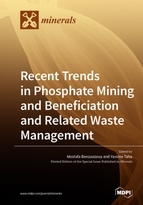Recent Trends in Phosphate Mining and Beneficiation and Related Waste Management
A special issue of Minerals (ISSN 2075-163X). This special issue belongs to the section "Mineral Processing and Extractive Metallurgy".
Deadline for manuscript submissions: closed (30 April 2019) | Viewed by 70950
Special Issue Editors
Interests: inorganic industrial and mining wastes; environmental characterization; treatment and recycling of industrial and mining wastes; waste reprocessing; integrated management of mining wastes
Special Issues, Collections and Topics in MDPI journals
Interests: sustainable mining; circular economy; mine waste repurposing; resource recovery; critical raw materials; industrial ecology
Special Issues, Collections and Topics in MDPI journals
Special Issue Information
Dear Colleagues,
Phosphate extraction and beneficiation is one of the vital mining industries in the world, especially for the agriculture and food industries. Phosphorus derived from phosphate rock is a vital element of life and an exceptional component in fertilizers. However, high-grade phosphate reserves are known to decrease and the need to explore low-grade ores including waste rocks and tailings to extract apatite minerals is becoming more and more crucial. Also, many streams of waste are continuously produced by the phosphate industry: calcareous and siliceous waste rocks, clayey sludge and phosphogypsum. These wastes are produced in huge volumes reaching a ratio between 5 to 10 tons of waste per each ton of concentrated phosphate. The management of these wastes is becoming a real concern in terms of public concerns and environmental and financial aspects. In addition, phosphate ores are known to contain other critical raw materials (CRM) such as rare earth elements and uranium. The recovery of these vital elements from phosphate wastes may help to develop the needs of the green energy of the future and contribute to the achievement of the sustainable development goals.
Insights related to the following aspects will be included in this Special Issue:
- Phosphate extraction and beneficiation,
- Novel phosphate ores
- Fine characterization of phosphate ores and waste
- Phosphoric acid production
- CRM recovery from phosphate ores and wastes,
- Reprocessing of phosphate wastes
- Valorization and reuse of phosphate wastes and phosphogypsum
Prof. Dr. Mostafa Benzaazoua
Prof. Yassine Taha
Guest Editors
Manuscript Submission Information
Manuscripts should be submitted online at www.mdpi.com by registering and logging in to this website. Once you are registered, click here to go to the submission form. Manuscripts can be submitted until the deadline. All submissions that pass pre-check are peer-reviewed. Accepted papers will be published continuously in the journal (as soon as accepted) and will be listed together on the special issue website. Research articles, review articles as well as short communications are invited. For planned papers, a title and short abstract (about 100 words) can be sent to the Editorial Office for announcement on this website.
Submitted manuscripts should not have been published previously, nor be under consideration for publication elsewhere (except conference proceedings papers). All manuscripts are thoroughly refereed through a single-blind peer-review process. A guide for authors and other relevant information for submission of manuscripts is available on the Instructions for Authors page. Minerals is an international peer-reviewed open access monthly journal published by MDPI.
Please visit the Instructions for Authors page before submitting a manuscript. The Article Processing Charge (APC) for publication in this open access journal is 2400 CHF (Swiss Francs). Submitted papers should be well formatted and use good English. Authors may use MDPI's English editing service prior to publication or during author revisions.
Keywords
- phosphate
- apatite
- beneficiation
- flotation
- waste rocks
- phosphogypsum
- low-grade ores
- phosphoric acid
- REE
- wastes valorization







